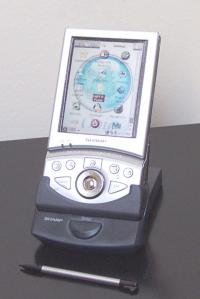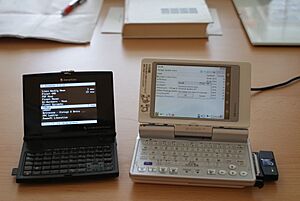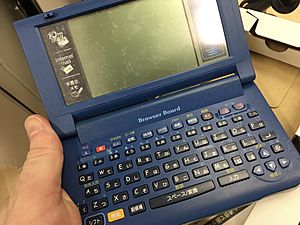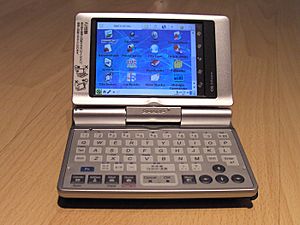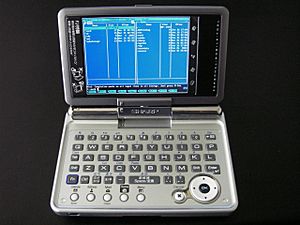Sharp Zaurus facts for kids
The Sharp Zaurus was a cool series of small, handheld computers called personal digital assistants (PDAs). They were made by a company called Sharp Corporation. In the 1990s, the Zaurus was super popular in Japan. It first used a special operating system made by Sharp. Later, some Zaurus models, like the SL-5000D, started using the Linux operating system. People even called them "true Linux PDAs" because Linux was built right into them. The name "Zaurus" sounds a bit like "dinosaur," which is where it came from!
Contents
History of Zaurus
In September 1993, Sharp launched the PI-3000. This was the very first Zaurus. It had a black and white screen, could understand handwriting, and could even communicate with other devices using light signals. The Zaurus quickly became one of Sharp's best-selling products.
The PI-4000 came out in 1994. It added a built-in modem and could send faxes. In 1995, the PI-5000 arrived, letting users send e-mail and connect to mobile phones and PCs. The Zaurus K-PDA was special because it had a keyboard, not just handwriting recognition.
In 1996, Sharp released the Sharp Zaurus ZR-5800. It looked similar to older models but had more memory and a screen that lit up.
Color Screens and Internet
Sharp was also making big steps in color screen technology. In May 1996, the first Zaurus with a color screen came out. These were the MI-10 and MI-10DC. They had a five-inch color screen and could connect to the internet. They even had a camera and could record sound! Later that year, the MI-10/10DC Zaurus was named the best product by a magazine in the United States.
Sharp kept improving its screens. In November 2000, the MI-E1 Zaurus was released in Japan. It could play videos and was the first Zaurus to use both Secure Digital (SD) and Compact Flash memory cards. These cards became standard on future models.
Even though the MI series sold well in Japan, it was not sold in other countries. The next big change was the SL series, which used the Linux operating system. The first Linux Zaurus was the SL-5000D, made for developers. Soon after, the SL-5500 came out. Both used a special version of Linux called 'Embedix' and a system called Qtopia for apps.
The MI series eventually stopped being made, with the MI-E25DC being the last one.
Newer Linux Models
Sharp continued to develop the SL series in Japan. Models like the SL-C700, C750, C760, and C860 had much clearer screens. They also used faster Intel XScale processors. These SL-C models were like small laptops, with a keyboard and a screen that could flip and turn. You could use them like a tiny notebook or fold them into a PDA.
In 2004, Sharp introduced the SL-6000. This model was different from the clamshell ones. It had a sliding screen that covered a small keyboard. The SL-6000L was sold in North America and had Wi-Fi.
In October 2004, Sharp announced the SL-C3000. This was the first PDA in the world to have a built-in hard drive! It had a 4 GB hard drive and a USB port.
In March 2005, the SL-C1000 was released. It was lighter and cheaper than the C3000 because it used flash memory instead of a hard drive. Then, in June 2005, the SL-C3100 came out. It had both flash memory and a hard drive, making it very popular.
The latest model, the SL-C3200, was launched in March 2006. It had a bigger 6 GB hard drive and came with updated software, including a dictionary and text-to-speech.
Even though Zaurus devices were mostly sold in Japan, some companies would export them to other countries. However, Sharp did not offer warranty or repair services outside Japan.
In January 2007, it was reported that Sharp would stop making the Zaurus line. Later, some newer units were made, but Sharp did not explain its plans. After this, Sharp released some devices that looked similar but ran Windows Mobile instead of Linux.
Zaurus Models
- Personal Information (PI) series
- PI-3000: The very first Zaurus, released in Japan in October 1993.
- PI-4000/FX: Added fax features in June 1994.
- PI-5000/FX/DA: Could connect to PCs, released in November 1994.
- PI-6000/FX: Featured new handwriting recognition software in August 1995.
- PI-7000: Called AccessZaurus, it had a built-in modem and came out in February 1996.
- PI-6500: Released in November 1996, it was small and light.
- PI-8000: Released in January 1997, with a clearer screen.
- PI-6600: The last AccessZaurus, released in September 1997.
- K-PDA (ZR) series
- ZR-3000: Had a touch screen and 1 MB of memory.
- ZR-3500: Similar to the ZR-3000, with a new internal modem.
- ZR-5000/FX: A clamshell model sold outside Japan, released in January 1995.
- ZR-5800: Had a backlit screen and 2 MB of memory.
- MI series
- MI-10DC/10: Nicknamed ColorZaurus, these were the first models with a color screen. The DC model had a digital camera. Released in June 1996.
- MI-E1: The first model with a vertical screen and a mini keyboard.
- MI-E25DC: An improved MI-E21 with a built-in camera.
- Other MI Series related devices
- Browser Board: A communication device with a keyboard.
- Linux based SL series
- SL-5000D: A special version for developers, with 32 MB of memory. (2001)
- SL-5500 (Collie): The first new Zaurus sold outside Japan. It had a 206 MHz processor, 64 MB of memory, a keyboard, and slots for memory cards. (2002)
- SL-A300 (Discovery): A very light PDA without a keyboard, sold only in Japan. (2003)
- SL-5600 (Poodle): An improved SL-5500 with a faster 400 MHz processor, speaker, and microphone. (2002)
- SL-C700 (Corgi): A clamshell model with a high-resolution screen, sold only in Japan. (2003)
- SL-C750 (Shepherd): An improved SL-C700 with longer battery life. (2003)
- SL-C760 (Husky): An improved SL-C700 with more storage and a bigger battery. (2004)
- SL-C860 (Boxer): Similar to SL-C760, with software that allowed it to connect as a USB storage device. (2004)
- SL-6000 (Tosa): The successor to the SL-5600, available in different versions with Wi-Fi and Bluetooth. (2005)
- SL-C3000 (Spitz): The first PDA with a 4 GB hard drive. It also had a USB port. Sold only in Japan.
- SL-C1000 (Akita): Similar to SL-C3000, but with 128 MB of flash memory instead of a hard drive.
- SL-C3100 (Borzoi): Had both 128 MB flash memory and a 4 GB hard drive.
- SL-C3200 (Terrier): The latest clamshell model, released in March 2006. It had a 6 GB hard drive and updated software.
Operating Systems
The operating system (OS) is the main software that makes a computer work. For Zaurus devices, the OS was usually stored in special memory. If something went wrong, there was a "rescue" mode to help fix it.
Many different operating systems were created for the Zaurus:
- OpenZaurus: This was an open-source OS that let users customize their Zaurus. It didn't include Sharp's own software. OpenZaurus development later moved to a new system called Ångström.
- Ångström distribution: This is the newer version of OpenZaurus. It supports many different devices, not just Zaurus.
- Cacko: This was another option that looked similar to Sharp's original OS but had many updated parts. It could still run Sharp's apps.
People also tried to put other operating systems on Zaurus devices, like Gentoo Linux, Ubuntu, and Arch Linux ARM. There were even attempts to run OpenBSD and NetBSD on some Zaurus models.
Software
Because the Zaurus used the Linux operating system, it could run many different kinds of software. This included both programs made by companies and open-source programs (which means their code is free for anyone to use and change).
Sharp provided basic PDA software like a calendar, address book, and to-do list. But many people also created other programs. For example, there were office programs, web browsers, and media players.
Even though Zaurus was mainly for business, many fun games were also made for it. Some companies and independent developers created games, and you could even find video game emulators to play classic games.
See also
 In Spanish: Sharp Zaurus para niños
In Spanish: Sharp Zaurus para niños


